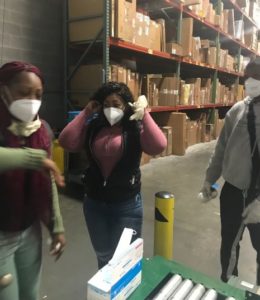CES 2024: Innovation is Back

CES 2024: Innovation is Back
I have been attending CES for the past 15 years, and we have seen the same, if not very similar things for all these years, so much so that it seems quite rote. CES 2024 was a very different story…the show truly rebounded from the COVID years, and innovation is back in full force.
CES is a portal into the future; it’s a portal into where we need to go as a company and in the residential environment. VR, AI, IoT – used to be just cool buzzwords. They are now very much here in the present and the future. Manufacturers, as well as consumers, are excitedly embracing this future. Those pushing the envelope will be the innovation leaders, challenging others to dig deep to remain relevant. At the core of all of this is the question: how will this innovation provide value to the consumer and open the door for after-sales support?
Using Technology for Cleaner and Safer Homes
No doubt a byproduct of the pandemic, home sanitization products were abundant, utilizing steam and UV light technology. This has led to families taking more notice of cleaning and sanitizing their homes, from removing shoes upon entering their homes, to wiping down doorknobs and other surfaces, to disinfecting and finding disinfecting cleaning supplies, all of which will be an important factor in the marketplace. It has given us food for thought and new insight into the cleanliness of our homes and business places. It is imperative that we have peace of mind, especially when it comes to our health and that of our families.
The all-in-one technology has also massively improved, with new technology wherein one machine washes and dries laundry. While we have had these machines for some time, the mechanics were not nearly as advanced as those coming to market now. This not only cuts down on time doing laundry, more importantly, it cuts down on utility consumption, saving the average family hundreds of dollars per year. Also with the new technology, the washer/dryer combo can text the consumer to let them know the load is finished and ready to fold! Ideally it would fold the laundry too… I think that will have to wait until the next generation!
3D Printing in the Parts Ecosystem
Based on the products and technology we saw at CES, I am sure that 3D printing will be part of the service parts ecosystem. It may never get to the point where a consumer would print a part at home, CAD requirements are significant. However, I think distributors or manufacturers could potentially print a part on demand. Plastic items like gears or knobs, a handle for your microwave or a range knob could easily be printed on these futuristic printers. While still in its early stages, I think 3D printing will be in the parts environment as a viable service repair option.
Nurturing Relationships in the Aftermarket Services
There were so many opportunities for supply chain at CES this year. There are new companies that need to move quickly to try to capture their share of the US market. Often, when at CES, we will see exceptional amounts of new brands that have innovative technology, and they are usually laser focused on the design, build, manufacturing and distribution of the product. That said, it seems that the after-purchase service is an “after-thought.”
The obvious questions for these consumer product startups:
“What are your ideas for the aftermarket? What are your plans to support your products, as well as other important questions, which is where we can assist these companies in educating them about after purchase support.
Think for a moment, of a customer purchasing the product that you have innovatively put hours or months or years into creating, and that product fails; what is the backup plan or support? That consumer is going to be much more forgiving if they buy a product that the manufacturer stands behind. A good service solution, with a qualified technician, good parts source, a good original new part that will not fail is imperative to providing a good quality product. On top of which, the support base will also provide feedback about the service experience. This could be the most important part of the brand building experience.
That’s where Encompass comes in, providing that kind of structure and insight, and the full-service solution for supply chain logistics.
We have a consumer direct platform with fully integrated API’s with most all service claims administration companies. We integrate with a multitude of claims management systems, field service networks, home warranty companies, and extended contract firms. For these startup companies that might be entering the home appliance, consumer electronics, personal care, power tools, lawn and garden, and/or the computer marketplace, we can provide an even stronger support experience. Encompass will provide the same full service, with all the bells and whistles, right out of the gate, very similarly as do the core manufacturers.
www.encompass.com
This is why we always make CES a priority to attend. Not only to meet with current customers and existing vendors, whom we already support and nurture, but to also seek out new companies entering the market that may not know that they need the excellent quality service that we can provide. We look forward to seeing everyone at CES 2025.



 first US state law to broadly protect a consumer’s right to repair their own Digital Electronic Equipment
first US state law to broadly protect a consumer’s right to repair their own Digital Electronic Equipment cited were Amazon and Google, which each took at least 10 years before dominating the web and ecommerce.
cited were Amazon and Google, which each took at least 10 years before dominating the web and ecommerce.
 Businesses have had to quickly adapt to keep operations running, while minimizing the risk of spreading disease and complying with state and federal guidelines. The pandemic has forced businesses to rethink their workforce strategies – perhaps for the better. Those that have resisted telecommuting, may find it leads to more productive, content employees, while saving infrastructure costs and/or freeing up space for inventory. With today’s interactive technology, working remotely has never been more viable.
Businesses have had to quickly adapt to keep operations running, while minimizing the risk of spreading disease and complying with state and federal guidelines. The pandemic has forced businesses to rethink their workforce strategies – perhaps for the better. Those that have resisted telecommuting, may find it leads to more productive, content employees, while saving infrastructure costs and/or freeing up space for inventory. With today’s interactive technology, working remotely has never been more viable. As we continue emerging from this unprecedented event, the long-term impact on the service repair industry is still yet to be realized. Some repair businesses have been forced to shut down permanently. With time on their hands and access to a wealth of “how to” videos online, there has been a sharp increase in consumer DIY repairs.
As we continue emerging from this unprecedented event, the long-term impact on the service repair industry is still yet to be realized. Some repair businesses have been forced to shut down permanently. With time on their hands and access to a wealth of “how to” videos online, there has been a sharp increase in consumer DIY repairs. Internal Response
Internal Response


